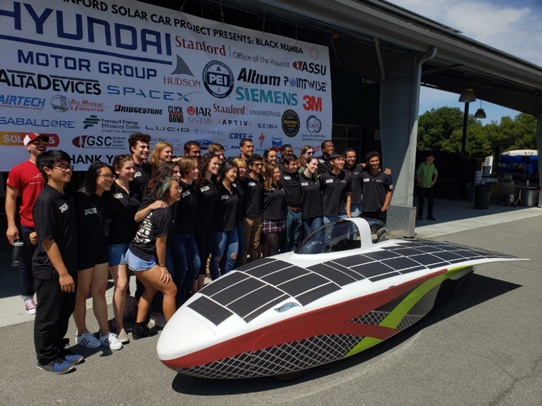- News
7 October 2019
Alta and Stanford Solar Car show potential of flexible, high-efficiency solar for automotive
Alta Devices of Sunnyvale, CA, USA (a subsidiary of Hanergy Thin Film Power Group Ltd of Beijing, China) says that its solar technology is powering the Stanford Solar Car competing in this month’s Bridgestone World Solar Challenge (BWSC) race.
Alta says that, for the first time in the BWSC, a solar car will use flexible, glass-free solar that also delivers high levels of power, and can also be manufactured at cost-effective prices.
“For solar to be realistic for the broad auto market, it needs to have several important characteristics,” says CEO Jian Ding. “It must be flexible enough to conform to the surfaces of innovative vehicle designs, maintain high efficiency even in the hottest weather conditions, and be manufacturable at scale.”
To date, solar technology used on solar race cars, luxury cars or concept vehicles has typically been silicon solar or specialized solar developed for space applications. Silicon solar, while low-cost, is very brittle, which makes it difficult to handle and integrate into curved automotive surfaces. Silicon has relatively low energy conversion efficiency compared with other materials, making it harder to generate the desired amount of power from the limited area of a car roof. Moreover, silicon solar quickly becomes warm during operation and loses efficiency as temperatures rise. Overall, this results in less vehicle range or available power per day. Space solar cells are high efficiency but, like silicon, are very brittle and don’t manage heat well. In addition, the traditional complex and time-consuming manufacturing process makes them very expensive.
Alta’s thin-film gallium arsenide solar technology is newer than silicon and space solar, and is flexible, lightweight, high efficiency and has structural properties that allow it to run much cooler. It can also be produced at mass-market scale.
2019 BWSC and Stanford Solar Car Project (SSCP)
The Bridgestone World Solar Challenge (BWSC) road race is over 30 years old, held every two years in the Australian outback, and covers a route more than 3000km (1864 miles) long from Darwin to Adelaide. Over 50 teams, composed of students from high schools and colleges, are competing. The race rules mandate that the cars must be designed, built and raced by the teams, and run primarily on solar power, with very limited use of stored energy.

Picture: The 2019 Stanford Solar Car.
The 2019 Stanford Solar Car Project (SSCP) solar car ‘Black Mamba’ has a sleeker design than previous team cars, and the Stanford team built a custom oven in which to cure the large shell composites. The car is the 14th solar car that the Stanford team has designed. This year’s design is asymmetrical with a single aerodynamic shell covering the body. Alta’s solar cells have been integrated onto the top surface of the vehicle.
Due to the ability of the solar to flex, the curves of the vehicle design were preserved. “In the future, mass-market electric vehicles will be designed for long range, as well as safety, and sustainability,” says Jian Ding. “They will use extremely lightweight and aerodynamic materials. Solar will be incorporated to seamlessly cover the body of the car, maximize range, and power auxiliary systems. Whenever there is sunlight, the car will always be charging.”


